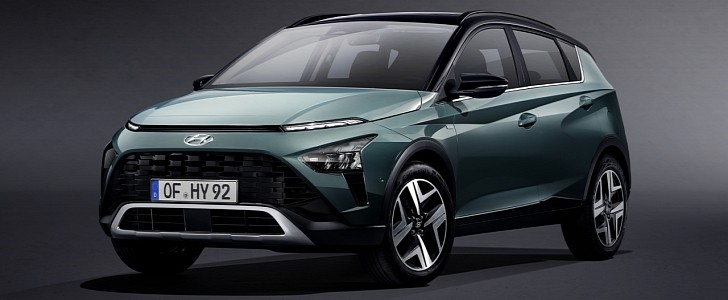This is the all-new Hyundai Bayon, a crossover that may signal the fact we’re not talking about a conventional way of developing or upgrading a brand’s range of models anymore. The car looks damn good, yet it seems the Koreans made it just because they could and had enough resources to do it. That said, the Hyundai Bayon’s dimensions are almost identical to those of the already known Hyundai Kona. And no, it is not a case of the Bayon replacing the Kona.
The subcompact crossover has a length of 4,180 mm, width of 1,775 mm, and a wheelbase of 2,580 mm, which means that the Hyundai Bayon and the Kona are the same size. However, the Bayon appears to be a bit bigger thanks to the design treatment. The third lateral window and the C-pillars are proportionally larger than those of the Kona. Another design cue to make the Bayon especially attractive is a premium, high-tech styling typical of the brand's latest models. We’ve seen this already with the Renault Captur, Seat Arona or VW T-Roc, but the Hyundai Bayon seems to push the trend further.
The name of the car should be appealing, especially for European customers since it was inspired by a popular holiday location in France, known as Bayonne (capital of the so-called Basque Country). Designer Luc Donckerwolke himself (yes, the same man who penned the Lamborghini Murciélago, now Chief Creative Officer at Hyundai Motor Group) praises his creation: “With its sharp look and integration of Hyundai’s SUV key design elements, Bayon solidifies Hyundai’s SUV design direction.”
Some very special colors were prepared by the design team to better underline the Bayon’s model identity. The Mangrove Green Pearl (with optional Phantom Black roof) is a striking example in this respect.
At this point, there is nothing really special regarding the engine range. The mild-hybrid powertrain with a 48V electrical system features a 1.0-liter T-GDi that belongs to the Kappa engine family and is available with power versions of 100 PS (99 hp) and 120 PS (118 hp). It can be mated with the 6-speed manual gearbox or a 7-speed dual clutch transmission (7DCT).
The name of the car should be appealing, especially for European customers since it was inspired by a popular holiday location in France, known as Bayonne (capital of the so-called Basque Country). Designer Luc Donckerwolke himself (yes, the same man who penned the Lamborghini Murciélago, now Chief Creative Officer at Hyundai Motor Group) praises his creation: “With its sharp look and integration of Hyundai’s SUV key design elements, Bayon solidifies Hyundai’s SUV design direction.”
Some very special colors were prepared by the design team to better underline the Bayon’s model identity. The Mangrove Green Pearl (with optional Phantom Black roof) is a striking example in this respect.
At this point, there is nothing really special regarding the engine range. The mild-hybrid powertrain with a 48V electrical system features a 1.0-liter T-GDi that belongs to the Kappa engine family and is available with power versions of 100 PS (99 hp) and 120 PS (118 hp). It can be mated with the 6-speed manual gearbox or a 7-speed dual clutch transmission (7DCT).














